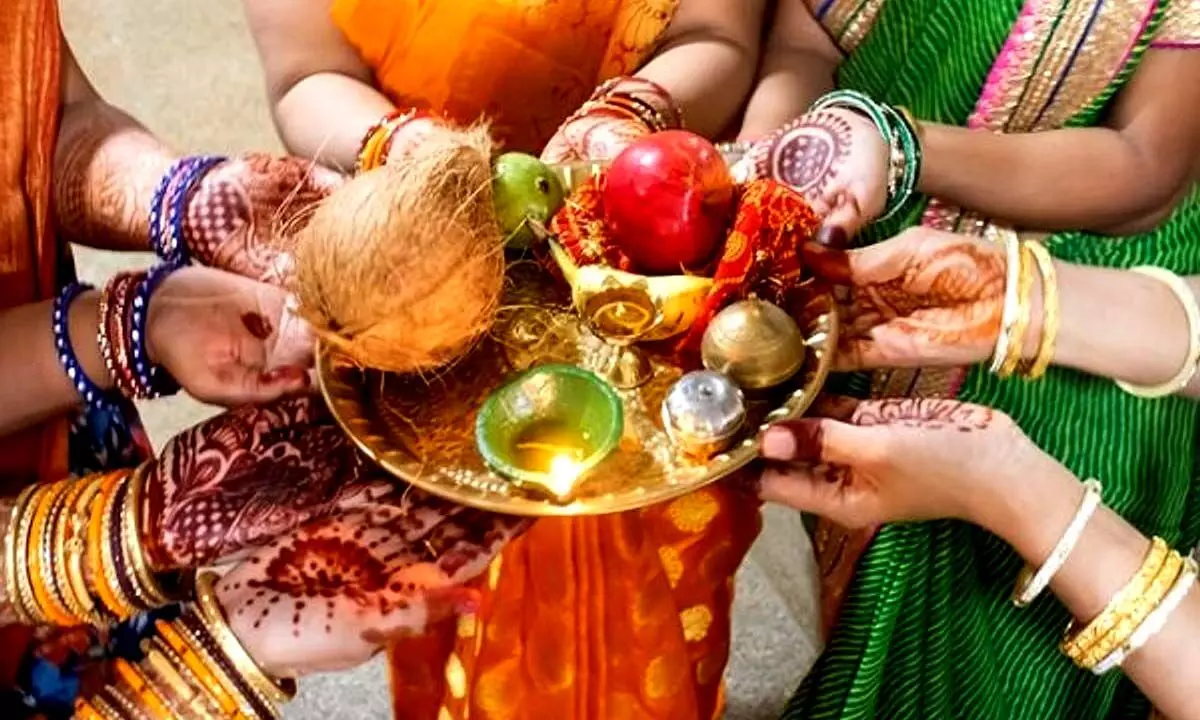Live
- Cyberabad police holds meet with hostel owners
- Guv read from Congress’ ‘lies-based’ script, flays BJP
- AP Assembly Budget Sessions: Key Discussions and Bills Set for Thursday
- Guv spoke like ‘Congress karyakarta’: KTR
- Governor’s address mirrors Rising Telangana: Congress
- RPF personnel assist woman to deliver safely at Sec’bad station
- VMRDA takes up two iconic projects in Vizag
- Chilkur priest meets former V-P Venkaiah Naidu
- CMR launches jewellery showroom in Eluru
- VPA celebrates Women’s Day
Kajari Teej 2024: Shubh Muhurat, Rituals, Significance, and Heartfelt Wishes


Kajari Teej, also known as KajliTeej, is a significant festival predominantly celebrated by married women across various regions of India, especially in northern states like Rajasthan, Uttar Pradesh, Bihar, and Madhya Pradesh.
Kajari Teej, also known as KajliTeej, is a significant festival predominantly celebrated by married women across various regions of India, especially in northern states like Rajasthan, Uttar Pradesh, Bihar, and Madhya Pradesh. It is one of the three major Teej festivals, with the other two being Hariyali Teej and Hartalika Teej. This festival typically occurs during the Krishna Paksha (waning phase of the moon) in the Bhadrapada month, which aligns with August-September in the Gregorian calendar. Kajari Teej is observed fifteen days after HariyaliTeej, three days post-Raksha Bandhan, and five days before Janmashtami.
Shubh Muhurat for Kajari Teej 2024
In 2024, Kajari Teej falls on Thursday, August 22. The Tritiya Tithi, marking the beginning of the festivities, starts at 5:06 PM on August 21 and concludes at 1:46 PM on August 22.
Heartfelt Wishes for Kajari Teej 2024
• May the blessings of Teej bring happiness, love, and prosperity to your life. Happy Kajari Teej!
• On this Kajari Teej, may your heart overflow with love, your home be filled with joy, and your life be blessed with prosperity.
• As the swings of Kajari Teej take you higher, may they also elevate your happiness and success.
• May Lord Shiva and Goddess Parvati bless you with a life full of love, happiness, and togetherness. Wishing you a joyous Kajari Teej!
• May the monsoon season bring endless happiness and harmony to your home. Wishing you and your loved ones a joyous Kajari Teej!
Rituals of Kajari Teej 2024
Fasting: Married women observe a rigorous fast on Kajari Teej, abstaining from both food and water as a symbol of their devotion and commitment to their husband’s well-being.
Breaking the Fast: Some women choose to break their fast only after sighting the moon or completing the evening rituals.
Worship: The day is dedicated to worshipping Goddess Parvati and Lord Shiva. Women offer flowers, fruits, and sweets, while reciting prayers and mantras dedicated to the divine couple.
Neem Worship: In certain regions, women perform rituals under a neem tree, which is considered sacred, as part of their devotion.
Mehndi Application: Applying mehndi (henna) on hands and feet is a vital aspect of the celebration, symbolizing love and auspiciousness.
Traditional Attire: Women adorn themselves in vibrant traditional attire, usually in red, green, or yellow, which are colors symbolizing fertility and prosperity. They also accessorize with jewelry and bangles, enhancing the festive atmosphere.
Folk Songs and Swings: Singing Kajari folk songs, which often depict themes of love, monsoon, and marital bliss, is a cherished tradition. Swings are a popular feature, symbolizing the joy of the monsoon season. Women take turns swinging, singing traditional songs that celebrate the spirit of the festival.
Significance of Kajari Teej
Kajari Teej holds profound significance for married women, who observe the festival to pray for the well-being, prosperity, and long life of their husbands. It is a day dedicated to seeking blessings for a harmonious and happy married life, honoring the divine union of Lord Shiva and Goddess Parvati. The festival is a celebration of marital devotion and love, with Goddess Parvati revered as the epitome of a devoted wife. Women observe the day with deep reverence, celebrating the sanctity of marriage and the eternal bond between husband and wife.

© 2025 Hyderabad Media House Limited/The Hans India. All rights reserved. Powered by hocalwire.com






